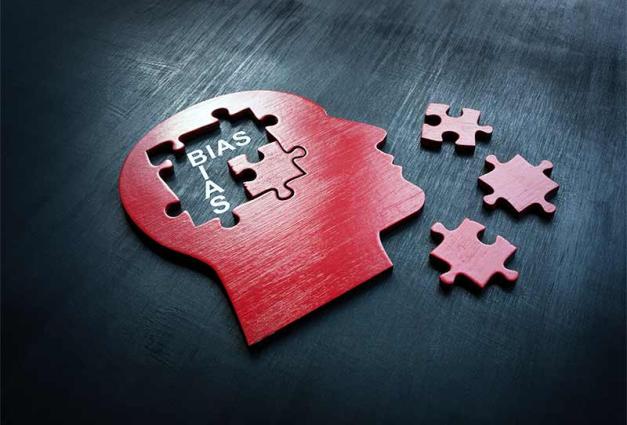On November 23, 1951—back when football helmets were 90% fashion statement and 10% safety equipment—undefeated Princeton played Dartmouth in a home game. In 1951, by the way, the Ivy League was very much like today’s Southeastern Conference. Think Alabama versus Georgia. Furthermore, Princeton’s top player, tailback Dick Kazmaier, had recently appeared on the cover of Time magazine.
The game got violent. In the second quarter, for example, Kazmaier was taken off the field with a broken nose. Yeah, in 1951, football helmets didn’t have faceguards. This classic game inspired a classic study in social psychology by Albert Hastorf and Hadley Cantril.
Hastorf and Cantril began by asking students at both Princeton and Dartmouth how they viewed the game. Specifically, they asked students at both schools if they felt there was “any truth to these charges … of dirty play by Dartmouth.” The answer depended on which school students attended. More than half of Princeton students—but only 10 percent of Dartmouth students—said that Dartmouth had played dirty. To be sure students weren’t just parroting the views of classmates, Hastorf and Cantril showed a film of the game to students at both school and asked them to count the infractions. After having just watched the same film, Princeton students counted more than twice as many infractions by Dartmouth (9.8) as did the Dartmouth students (4.3). Hastorf and Cantril concluded that “the ‘game’ was actually many different games and that each version of the events that transpired was just as ‘real’ to a particular person as other versions were to other people.”
Hastorf and Cantril documented what writer Anaïs Nin had said about human perception: “We don’t see things as they are, we see them as we are.” Decades later, this idea is still important. In today’s world of extreme political polarization, we should all acknowledge how much our pre-existing wishes and beliefs influence what we perceive. Consider views of “The Wall,” tariffs, and health care, for example. The growing gap between how liberals and conservatives view the world is grounded, in large part, in the natural human tendency for us to see what we hope and expect to see.
But knowing that human perception is inherently biased does not necessarily doom us to drift in a sea of uncertainty. Consider two very different topics on which U.S. Democrats and Republicans strongly disagree. In our view, people can be very certain about one but must admit to much greater uncertainty about the other. To begin with uncertainty, it’s very difficult to say for sure, whether Brett Kavanaugh sexually assaulted Christine Blasey Ford almost four decades ago. This single alleged event happened long ago, and there is no known physical evidence of it. On the other hand, if there had been a dozen disinterested eyewitnesses to this alleged event, if their stories closely converged, and if there were both videotape evidence and DNA evidence to support one account of the event over the other, Democrats and Republicans should be closer together about what happened.
In contrast to this example, a tremendous amount of hard scientific evidence supports the reality of climate change. Thousands of independent, carefully collected data points that relied on dozens of different ways of assessing climate change all converge on the same unhappy answer. Although it is possible that scientists are wrong about climate change, it is simply false to deny that there is near universal scientific consensus that climate change exists—and that a significant cause is human activity. (As you can read elsewhere in Character and Context, one of the best ways to convince skeptical laypeople that climate change is real is to tell them (truthfully) that 97% of climate scientists believe climate change is real. See van der Linden and colleagues at https://spsp.org/news-center/blog/consensus-gateway-bridge.)
With this last finding in mind, consider a recent Business Insider report by Andy Kiersz and Skye Gould. These authors brought together data from a wide range of national polls to show that there are at least a dozen important political issues on which the very large majority of Americans agree. For example, in 2016, only about 4% of Americans believed that the U.S. government spends too much money on roads and highways. Only about 6% believed that the U.S. government spends too much money on education. People like to get places. And when they get there, they like to meet people who know things. Along similar lines, more than 80% of Americans were in favor of paid leave for people who have to cope with major illnesses, who give birth, or who adopt a child. Finally, at least 80% of Americans say it bothers them either “some” or “a lot” that wealthy Americans and corporations do not pay their fair share of taxes.
In short, perhaps America is not quite as divided as we often think. Perhaps people on both sides of the aisle are open to data. In fact, even in Hastorf and Cantril’s classic study, there were some things students from both Princeton and Dartmouth agreed about. For example, there was pretty solid consensus that Dartmouth had played a rougher game than Princeton had. Along similar lines, a 2014 Pew Research Center poll revealed both disagreement and agreement about what sources of news and information Americans trust. On the worrisome side, liberals and conservatives disagreed dramatically about whether one can trust The Rush Limbaugh Show or NPR. But the same 2014 Pew poll showed that people from all political points of view, from the extreme left to the extreme right, viewed the Wall Street Journal as more trusted than distrusted. Conversely, people on the left as well as the right viewed Buzzfeed as more distrusted than trusted. Sorry to be a buzzkill, Buzzfeed.
So, if voters and public policy advocates can get politicians to talk more about what almost all of us agree about—without ignoring serious areas of disagreement—perhaps we can build better schools and roads, take better care of growing families, and even reduce social inequality. In fact, research in social psychology suggests that a powerful way to reduce tensions between conflicting groups is to identify and then work toward shared goals (superordinate goals) that deeply matter to both groups. If Democrats and Republicans can begin to cooperate to reach shared goals, the partisan divide may become less debilitating in the future.
For Further Reading
Hardin, C.D. & Higgins, E.T. (1996). Shared reality: How social verification makes the subjective objective." Handbook of Motivation and Cognition: The Interpersonal Context Volume 3. Eds. E.T. Higgins and R.M. Sorrentino. New York: Guilford.
Hastorf, A. & Cantril, H. (1954). They saw a game; a case study. The Journal of Abnormal and Social Psychology, 49, 129-134.http://dx.doi.org/10.1037/h0057880
Kiersz, A. & Gould., S. (2019). 12 Issues Almost All Americans Agree On. Business Insider, Retrieved November 6, 2019 from https://www.businessinsider.com/american-attitudes-on-key-issues-2017-6
Mitchell, A., Gottfried, J., Kiley, J., & Matsa, K.E. (2014). Political Polarization & Media Habits. Retrieved November 4, 2019 from https://www.journalism.org/2014/10/21/political-polarization-media-habits/
The Wall Street Journal. Impeachment Increasingly Divides Americans by Political Party. Retrieved November 4, 2019 from https://www.wsj.com/articles/impeachment-increasingly-divides-americans-by-political-party-11572789600
Brett Pelham is a social psychologist who studies social perception, culture, and judgment and decision-making. He is also an associate editor at Character and Context.
Curtis Hardin is a social psychologist at Brooklyn College who studies stereotypes, identity, and shared reality theory.




